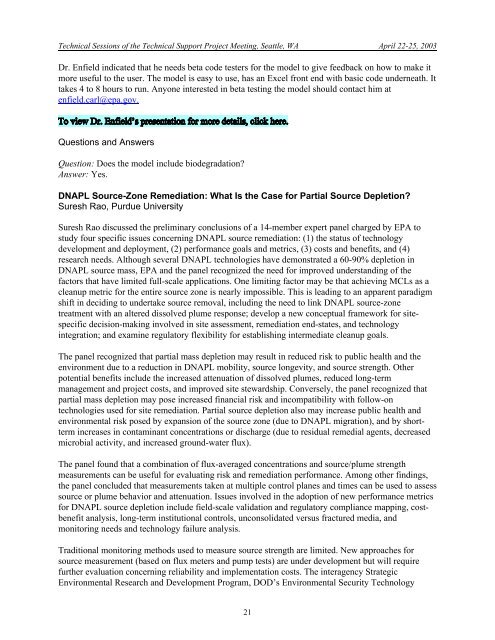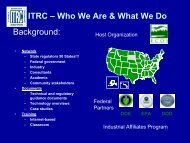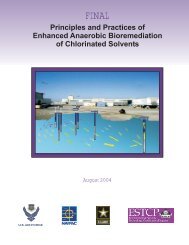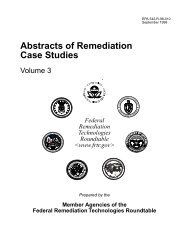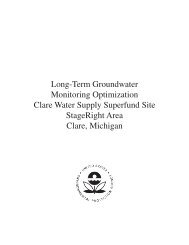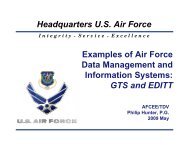Technical Sessions - Environmental Management Support, Inc.
Technical Sessions - Environmental Management Support, Inc.
Technical Sessions - Environmental Management Support, Inc.
You also want an ePaper? Increase the reach of your titles
YUMPU automatically turns print PDFs into web optimized ePapers that Google loves.
<strong>Technical</strong> <strong>Sessions</strong> of the <strong>Technical</strong> <strong>Support</strong> Project Meeting, Seattle, WA April 22-25, 2003<br />
Dr. Enfield indicated that he needs beta code testers for the model to give feedback on how to make it<br />
more useful to the user. The model is easy to use, has an Excel front end with basic code underneath. It<br />
takes 4 to 8 hours to run. Anyone interested in beta testing the model should contact him at<br />
enfield.carl@epa.gov.<br />
Questions and Answers<br />
Question: Does the model include biodegradation?<br />
Answer: Yes.<br />
DNAPL Source-Zone Remediation: What Is the Case for Partial Source Depletion?<br />
Suresh Rao, Purdue University<br />
Suresh Rao discussed the preliminary conclusions of a 14-member expert panel charged by EPA to<br />
study four specific issues concerning DNAPL source remediation: (1) the status of technology<br />
development and deployment, (2) performance goals and metrics, (3) costs and benefits, and (4)<br />
research needs. Although several DNAPL technologies have demonstrated a 60-90% depletion in<br />
DNAPL source mass, EPA and the panel recognized the need for improved understanding of the<br />
factors that have limited full-scale applications. One limiting factor may be that achieving MCLs as a<br />
cleanup metric for the entire source zone is nearly impossible. This is leading to an apparent paradigm<br />
shift in deciding to undertake source removal, including the need to link DNAPL source-zone<br />
treatment with an altered dissolved plume response; develop a new conceptual framework for sitespecific<br />
decision-making involved in site assessment, remediation end-states, and technology<br />
integration; and examine regulatory flexibility for establishing intermediate cleanup goals.<br />
The panel recognized that partial mass depletion may result in reduced risk to public health and the<br />
environment due to a reduction in DNAPL mobility, source longevity, and source strength. Other<br />
potential benefits include the increased attenuation of dissolved plumes, reduced long-term<br />
management and project costs, and improved site stewardship. Conversely, the panel recognized that<br />
partial mass depletion may pose increased financial risk and incompatibility with follow-on<br />
technologies used for site remediation. Partial source depletion also may increase public health and<br />
environmental risk posed by expansion of the source zone (due to DNAPL migration), and by shortterm<br />
increases in contaminant concentrations or discharge (due to residual remedial agents, decreased<br />
microbial activity, and increased ground-water flux).<br />
The panel found that a combination of flux-averaged concentrations and source/plume strength<br />
measurements can be useful for evaluating risk and remediation performance. Among other findings,<br />
the panel concluded that measurements taken at multiple control planes and times can be used to assess<br />
source or plume behavior and attenuation. Issues involved in the adoption of new performance metrics<br />
for DNAPL source depletion include field-scale validation and regulatory compliance mapping, costbenefit<br />
analysis, long-term institutional controls, unconsolidated versus fractured media, and<br />
monitoring needs and technology failure analysis.<br />
Traditional monitoring methods used to measure source strength are limited. New approaches for<br />
source measurement (based on flux meters and pump tests) are under development but will require<br />
further evaluation concerning reliability and implementation costs. The interagency Strategic<br />
<strong>Environmental</strong> Research and Development Program, DOD’s <strong>Environmental</strong> Security Technology<br />
21


